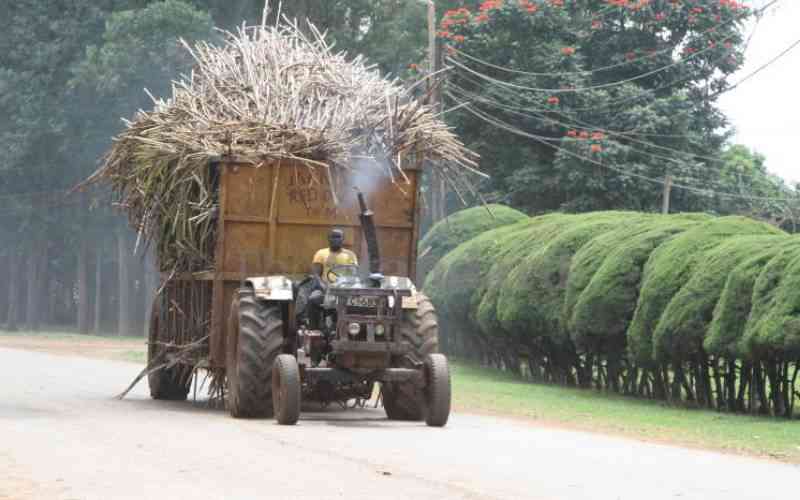By Winsley Masese
Kenya: Samson Nairengi has taken a bold stand against maize production.
High output costs, falling prices, diseases and unpredictable weather patterns have made growing Kenya’s most widely consumed crop untenable for him, so he has shifted to a more profitable option.
“I used to grow maize on three acres, but I now grow the crop on an acre and the rest is under sugarcane,” Mr Nairengi, who is from Transmara, Narok County, told Business Beat.
And he is not alone. Sugarcane has become the crop of choice for many disillusioned maize farmers in Transmara, especially after Deputy President William Ruto commissioned a sugar miller in the area.
Availability
Kenya’s food security has traditionally been pegged on the production and availability of maize, which explains the widespread concern over the number of farmers turning their backs on the crop.
There are also several million people who consider a meal incomplete without a plate of ugali. Tellingly, Nairenge said that despite the allure of sugarcane, area residents are worried about not being able to afford to put food on their tables.
“The granaries, which used to be full, are now empty and the majority of us have turned to buying maize from the market,” he said.
It is expected that the country will face a maize shortage of about six million bags this year, a deficit that would increase the price of the crop.
A ministry of Agriculture report released in November last year indicated that while the land under maize increased marginally from 1.077 million hectares in 2012 to 1.084 million hectares in 2013, the crop’s yield slumped.
Production shrank to 26.2 million bags last year from 28.8 million bags in 2012.
The good news, however, is that the acreage under crops like Irish potatoes, wheat, cassava, sorghum and sweet potatoes has increased.
Cassava, sorghum and sweet potatoes are nutrient-rich, drought-tolerant and disease-resistant crops, and their improved cultivation and production could cushion Kenyans from the constant threat of food shortages.
Further, the area under wheat production increased by only 415 hectares, yet production went up to 2.9 million bags from 2.1 million in 2012.
Wheat is the second-most consumed crop in the country, with rice coming in third.
The report, which was done in collaboration with the Food and Agriculture Organisation, noted: “The major crops that rely on heavy fertiliser and seed investment coupled with the high cost of land preparation had reduced hectares; while sorghum, cassava, Irish and sweet potatoes had an expanded area due to the low investment required for their establishment.”
The situation is likely to force many households to diversify their eating habits, but as the ministry of Agriculture report indicates, there are adequate alternatives.
Good prospects
“There are good prospects for the expansion of the industrial market for sorghum if its yields can rise fast enough to catch up with yields of competing cereals,” the report notes.
Sorghum is the fifth-leading cereal in terms of world production. A report by the International Crops Research Institute for the Semi-Arid Tropics states that it has high economic potential because of its industrial uses, which include animal feed and brewing.
In Kenya, 52 per cent of the sorghum produced is grown in Nyanza and 23 per cent in Western, with an average three kilogrammes consumed per year per person.
Finger millet is also increasingly becoming popular among resource-poor farmers in eastern and southern Africa.
It fetches good market prices, requires minimal capital input and is ideal for the management of malnutrition and diseases like diabetes, measles and anaemia.
[email protected]
 The Standard Group Plc is a multi-media organization with investments in media
platforms spanning newspaper print operations, television, radio broadcasting,
digital and online services. The Standard Group is recognized as a leading
multi-media house in Kenya with a key influence in matters of national and
international interest.
The Standard Group Plc is a multi-media organization with investments in media
platforms spanning newspaper print operations, television, radio broadcasting,
digital and online services. The Standard Group is recognized as a leading
multi-media house in Kenya with a key influence in matters of national and
international interest.
 The Standard Group Plc is a multi-media organization with investments in media
platforms spanning newspaper print operations, television, radio broadcasting,
digital and online services. The Standard Group is recognized as a leading
multi-media house in Kenya with a key influence in matters of national and
international interest.
The Standard Group Plc is a multi-media organization with investments in media
platforms spanning newspaper print operations, television, radio broadcasting,
digital and online services. The Standard Group is recognized as a leading
multi-media house in Kenya with a key influence in matters of national and
international interest.









